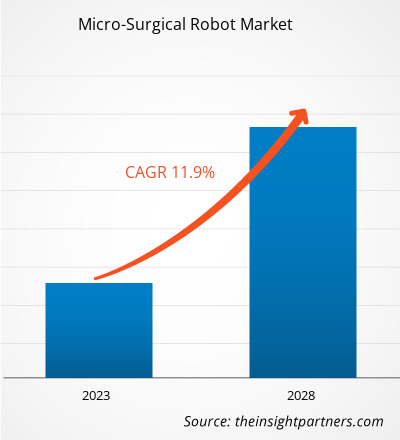The micro-surgical robot market is expected to grow from US$ 1,280.81 million in 2022 to US$ 2,817.57 million by 2028; it is expected to grow with a CAGR of 11.9% from 2022 to 2028.
Micro-surgical robots are used to perform microsurgeries, i.e., intracorporal and extracorporeal surgical procedures. Robots can assist in performing a complex surgical procedures more flexibly and precisely, which is possible with conventional techniques. Micro-surgical robots perform minimally invasive surgical procedures with tiny incisions. The advantages of micro-surgical robots are fewer complications, small scars, less blood loss, and quicker recovery. The increasing popularity of minimally invasive surgical procedures, and the advantages of robotic surgeries in terms of accuracy, repeatability, control, and efficiency fuel the global micro-surgical robot market growth. However, the high cost of micro-surgical robots and unfavorable reimbursement scenarios in different countries are hampering the market growth.
The report offers insights and in-depth analysis of the global micro-surgical robot market, emphasizing parameters such as market trends, technological advancements, market dynamics, and competitive landscape analysis focused on leading market players. It also includes the impact of the COVID-19 pandemic on the market across all regions. Many health authorities recommended avoiding human contact due to growing transmission and strain on healthcare resources by postponing elective surgeries, suspending out-patient clinics, and triaging employees involved in urgent care. Robotic surgeries utilize artificial intelligence (AI), which benefits through three aspects: increasing accuracy and reducing the risk of failure by providing shared and complete autonomy in simple tasks; allowing physical distancing by changing the surgeon’s role from executive to supervisory and from continuous control personnel to intermittent control personnel; and increasing the average number of surgical procedures, which will be required to address the backlogged surgeries caused by the shutdown of elective surgeries over a long period. Thus, the global micro-surgical robot market experienced a positive impact post the first wave of COVID-19.
Customize This Report To Suit Your Requirement
You will get customization on any report - free of charge - including parts of this report, or country-level analysis, Excel Data pack, as well as avail great offers and discounts for start-ups & universities
Micro-Surgical Robot Market: Strategic Insights

-
Get Top Key Market Trends of this report.This FREE sample will include data analysis, ranging from market trends to estimates and forecasts.
The global micro-surgical robot market is segmented on the basis of component, application, end user, and geography. By geography, the market is broadly segmented into North America, Europe, Asia Pacific, the Middle East & Africa, and South & Central America.
Market Insights
Advantages of Robotic Surgeries in Terms of Accuracy, Repeatability, Control, and Efficiency
The introduction of robotic surgery is the most recent advancement in liposuction. A surgeon controls the treatments from a master console, while the robotic patient cart performs the procedures more easily and precisely than laparoscopic systems. Owing to its 3D vision and accuracy, and intuitive multi-range instruments, robotic surgery has distinct advantages in liposuction procedures over traditional laparoscopic surgeries, ensuring greater patient safety. Robotic surgeries also aid in the improvement of suturing abilities, and reduction in post-operative pain and recovery time. Robotically aided liposuction is also recommended for obese individuals weighing more than 250 kg, as laparoscopic liposuction is more demanding and difficult. As per an article - “Comparison of surgical outcomes between integrated robotic and conventional laparoscopic surgery for distal gastrectomy: a propensity score matching analysis”, published in 2020, the surgical success rate in the integrated robotic distal gastrectomy (IRDG) group was 98%, significantly higher than the success rate in conventional laparoscopic distal gastrectomy (CLDG) group, i.e., 89.5%. Although both groups had similar rates of in-patient and out-patient problems, the readmission rate of the IRDG group was much lower than the CLDG group. Further, robotic surgeries aid better visualization capabilities, providing surgeons a better view of the work area and allowing them to see microscopic details using high-definition cameras. These systems have more dexterity than the human hand, and their ability to rotate 360° and navigate better allows surgeons to reach hard-to-access areas. A team of researchers has combined a nitrogen-powered arm (as a fifth robotic arm) with an optical magnification video lens system (Point-Setter arm and VITOM lens from Karl Storz, Tuttlingen, Germany) to develop a robotic platform for extracorporeal robotic microsurgical treatments. The VITOM is an HD exoscopic video system with optical lenses used for spine surgery and pediatric surgery. The optical magnification in the system ranges from 16× to 25×. The microsurgeon can view the image from the VITOM system just below the main 3D robot camera view using the TilePro imaging software in the surgeon interface. Thus, robotic microsurgeries ensure greater accuracy, repeatability, control, and efficiency. In line with the growing desire for better and faster healthcare services, these benefits of micro-surgical robots propel the market growth.
Component-Based Insights
Based on component, the global micro-surgical robot market is bifurcated into instruments and accessories. In 2022, the instruments segment is expected to have a larger market share. The market for this segment is estimated to grow at a faster CAGR during the forecast period.
Application-Based Insights
Based on application, the micro-surgical robot market is segmented into plastic reconstructive surgery, ENT surgery, urology surgery, neurosurgery, ophthalmic surgery, lymphatic surgery, and others. In 2022, the urology surgery segment is estimated to account for the largest share of the market. The same segment is expected to register the highest CAGR from 2022 to 2028.
End User-Based Insights
Based on end user, the micro-surgical robot market is segmented into hospitals & clinics,ambulatory surgical centers, research institutes, and others. In 2022, the hospitals and clinics segment is expected to hold the largest share of the market. The same segment is expected to register the highest CAGR from 2022 to 2028. The growth of the micro-surgical robots market for the hospitals & clinics segment is attributed to the rise in number of surgical procedures and the adoption of advanced equipment in these facilities.
The micro-surgical robot market players adopt organic strategies such as product launch and expansion to expand their global footprint and product portfolio, and meet the growing demand. For example, in May 2022, MMI S.p.A. announced the launch of its Symani Surgical System Simulator, developed by VirtaMed.
Geography-Based Insights
By geography, the global micro-surgical robot market is segmented into North America, Europe, Asia Pacific (APAC), the Middle East & Africa (MEA), and South & Central America. The market in North America is further segmented into the US, Canada, and Mexico. The micro-surgical robot market in Europe is sub-segmented into France, Germany, the UK, Spain, Italy, and the Rest of Europe. The APAC micro-surgical robot market is sub-segmented into China, India, Japan, Australia, South Korea, and the Rest of APAC. The market in the MEA is further segmented into Saudi Arabia, the UAE, South Africa, and the Rest of MEA. The micro-surgical robot market in South & Central America is sub-segmented into Brazil, Argentina, and the Rest of SAM
Micro-Surgical Robot Market Regional InsightsThe regional trends and factors influencing the Micro-Surgical Robot Market throughout the forecast period have been thoroughly explained by the analysts at The Insight Partners. This section also discusses Micro-Surgical Robot Market segments and geography across North America, Europe, Asia Pacific, Middle East and Africa, and South and Central America.
Micro-Surgical Robot Market Report Scope
| Report Attribute | Details |
|---|---|
| Market size in 2022 | US$ 1.28 Billion |
| Market Size by 2028 | US$ 2.82 Billion |
| Global CAGR (2022 - 2028) | 11.9% |
| Historical Data | 2020-2021 |
| Forecast period | 2023-2028 |
| Segments Covered |
By Component
|
| Regions and Countries Covered |
North America
|
| Market leaders and key company profiles |
|
Micro-Surgical Robot Market Players Density: Understanding Its Impact on Business Dynamics
The Micro-Surgical Robot Market is growing rapidly, driven by increasing end-user demand due to factors such as evolving consumer preferences, technological advancements, and greater awareness of the product's benefits. As demand rises, businesses are expanding their offerings, innovating to meet consumer needs, and capitalizing on emerging trends, which further fuels market growth.

- Get the Micro-Surgical Robot Market top key players overview
Major Companies
MMI S.p.A.; Microsure B.V.; Stryker Corporation; Intuitive Surgical, Inc.; Medtronic; Galen Robotics, Inc.; Ethicon (Johnson & Johnson Services, Inc.); Asensus Surgical, Inc.; Zimmer Biomet; Titan Medical Inc.; and ForSight Robotics LTD are among the leading companies operating in the global micro-surgical robot market.
Frequently Asked Questions
Who are the key players in the microsurgical robot market?
Which application held the largest share in the microsurgical robot market?
Which component led the microsurgical robot market?
What is the market CAGR value of the microsurgical robot market during the forecast period?
What are the driving factors for the microsurgical robot market across the globe?
What is microsurgical robot?
- Historical Analysis (2 Years), Base Year, Forecast (7 Years) with CAGR
- PEST and SWOT Analysis
- Market Size Value / Volume - Global, Regional, Country
- Industry and Competitive Landscape
- Excel Dataset
Recent Reports
Related Reports
Testimonials
Reason to Buy
- Informed Decision-Making
- Understanding Market Dynamics
- Competitive Analysis
- Identifying Emerging Markets
- Customer Insights
- Market Forecasts
- Risk Mitigation
- Boosting Operational Efficiency
- Strategic Planning
- Investment Justification
- Tracking Industry Innovations
- Aligning with Regulatory Trends





















 Get Free Sample For
Get Free Sample For